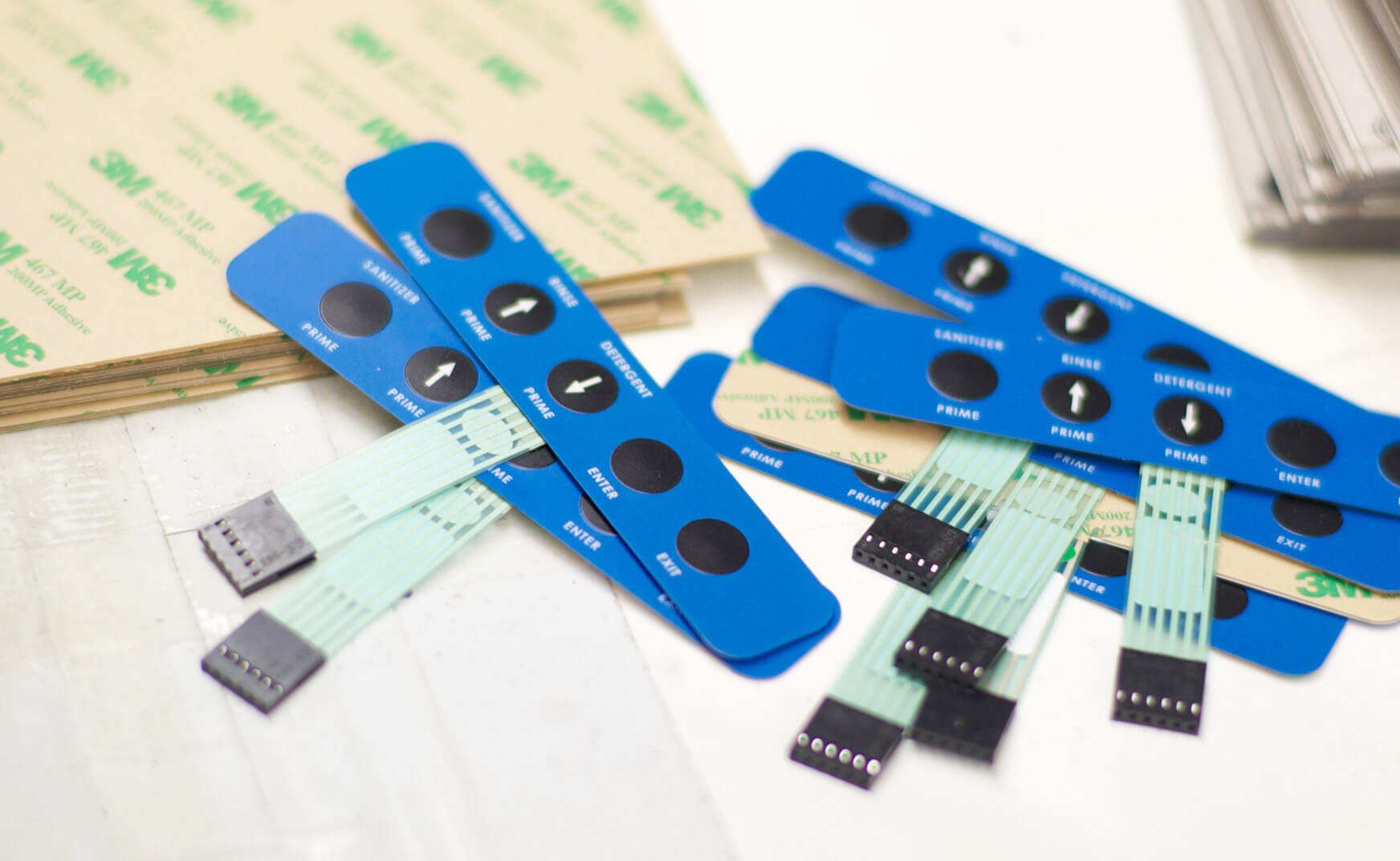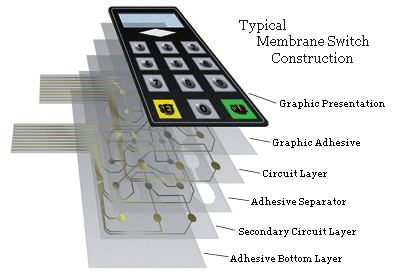Teaming up with an experienced membrane switch manufacturer helps streamline your production process.
Teaming up with an experienced membrane switch manufacturer helps streamline your production process.
Blog Article
All Regarding Membrane Change: Recognizing Its Design and Capability
When you think about the control user interfaces in modern-day gadgets, membrane buttons often come to mind. Let's discover what sets membrane switches apart from other control systems.
What Are Membrane Switches?

Membrane layer switches can likewise be personalized concerning shape, dimension, and graphics, allowing producers to develop special interfaces customized to certain products. Overall, membrane switches play a substantial role in improving individual experience across a large variety of applications.
How Membrane Layer Changes Job
When you press a key on a membrane switch, it activates an uncomplicated yet efficient device. membrane switch manufacturer. The leading layer, typically made of flexible product, pushes down onto a conductive layer beneath it.
You'll see that the tactile responses differs based upon the switch layout, using either a soft click or a more noticable response. As soon as you release the key, the membrane layer go back to its original placement, reopening the circuit and stopping the signal. This procedure occurs nearly immediately, ensuring a responsive individual experience.
Membrane layer switches are prominent due to their sturdiness and resistance to dust and moisture, making them excellent for numerous applications, from home devices to medical devices. Recognizing this procedure helps you appreciate their prevalent usage.
Key Elements of Membrane Switches
Comprehending the essential elements of membrane layer buttons is fundamental for realizing their functionality and layout. At the core, you'll locate the graphic overlay, which offers the aesthetic interface for customers. Underneath that, there's a spacer layer that separates the circuit layers, ensuring that they do not make call till pressed. The circuit layer is where the magic takes place; it contains conductive traces that complete the circuit when you push the switch. Another essential element is the adhesive backing, enabling the switch to comply with surfaces securely. The protective layer shields against ecological factors and put on, expanding the button's life expectancy. Each element plays a significant duty in ensuring trusted performance and individual interaction. By understanding these elements, you'll acquire insight right into just how membrane layer switches operate and their relevance in various applications.
Materials Used in Membrane Change Layout
The performance and toughness of membrane layer switches greatly rely on the products used in their style. You generally come across polyester and polycarbonate as key substrates as a result of their exceptional stamina and adaptability. These materials resist scrapes and chemicals, making them optimal for requiring settings.
The conductive layers commonly make use of silver or carbon, chosen for their integrity and conductivity. membrane switch manufacturer. Silver gives exceptional efficiency, while carbon is an economical choice. For the overlay, you might think about a matte or shiny finish, depending on your visual demands and user experience
Adhesives play a necessary role as well; they bond layers firmly and assure longevity. Make specific to choose adhesives that endure ecological aspects like temperature level and moisture. Don't forget the significance of a good printing method for graphics, as it improves both performance and visual allure. Picking the best materials will assure your membrane layer button stands the examination of time.
Layout Factors To Consider for Membrane Switches
While making membrane layer buttons, it's vital to think about numerous aspects that influence their performance and customer experience. Beginning by concentrating on the layout and button size; make specific they're intuitive and very easy to browse. Take into consideration the tactile responses you wish to supply-- will customers require a visible click or a softer touch? Furthermore, consider the products you'll utilize, as they'll impact durability and looks.
Do not forget the graphic layout; clear labeling and shade comparison are substantial for presence. Validate your layout fits ecological elements, like dampness or temperature variations, which can influence performance. Keep in mind the value of screening prototypes with real individuals to gather comments and make needed adjustments. This repetitive process aids you refine the layout, verifying it satisfies both functional and visual requirements effectively. By meticulously taking into consideration these aspects, you'll create a membrane switch that improves use and fulfillment.
Applications of Membrane Layer Switches
Membrane layer switches are versatile elements discovered in different applications, from industrial equipment to consumer electronic devices. You'll see their influence in machines that call for durable interfaces and in gadgets that benefit from sleek styles. Recognizing these applications aids you appreciate the capability and practicality of membrane switches in everyday modern technology.
Industrial Equipment Usage
When you're seeking to improve the performance of industrial tools, membrane switches provide a dependable solution that incorporates toughness with user-friendly design. These buttons are best for extreme environments, offering resistance to dust, moisture, and chemicals. You'll locate them in control panels for making makers, a/c systems, and clinical tools, where precision and responsiveness are important. Their reduced account suggests they fit perfectly right into different devices, conserving important area while maintaining ease of use. With personalized graphics and backlighting choices, you can develop an instinctive user interface for operators, enhancing effectiveness and safety and security. Plus, their lengthy lifespan decreases upkeep expenses, making check out here them a clever investment for your industrial applications. Welcome membrane buttons to streamline your operations and boost overall performance.
Consumer Electronics Integration
In the domain name of consumer electronics, membrane switches play a vital duty in boosting individual communication and tool capability. Membrane layer switches likewise guarantee sturdiness and resistance to dust and dampness, extending the life-span of your electronics. By choosing membrane buttons, you boost not just the performance however likewise the style of your devices, making everyday interactions smooth and satisfying.
Advantages and Downsides of Membrane Layer Switches
While membrane buttons provide a series of benefits, they additionally include some downsides that you must consider. One significant advantage is their small design, making them suitable for space-constrained applications. They're additionally economical, supplying a long lasting option with a low manufacturing price. In addition, their seamless surface area is easy to clean, enhancing hygiene in environments like medical facilities.

Membrane buttons can have a shorter life-span contrasted to mechanical switches, specifically under hefty use. They can also be much less tactile, which could affect user feedback throughout operation. Stabilizing these pros and cons will assist you figure out if membrane layer buttons are the right fit for your project.
Regularly Asked Inquiries
How Much Time Do Membrane Changes Commonly Last?
Membrane changes generally last in between 5 to 10 years, depending upon use and ecological conditions. You'll wish to assess variables like wear, exposure to wetness, and temperature fluctuations to gauge their longevity efficiently.
Can Membrane Switches Be Personalized for Certain Styles?
Yes, you can tailor membrane layer buttons to fit specific layouts (membrane switch manufacturer). You'll have the liberty to select shades, shapes, and designs that match your job's needs, ensuring they blend flawlessly with your total visual
What Is the Cost Variety for Membrane Layer Switch Production?
The expense array for membrane switch manufacturing usually drops between $1 and $10 each, relying on variables like layout complexity, amount, and materials. You can obtain quotes from manufacturers to locate the very best choice.

Are Membrane Layer Changes Water Resistant or Immune?
Membrane buttons can be developed to be waterproof or resistant, relying on products utilized and construction approaches. If you need them for damp atmospheres, guarantee you define those requirements throughout the layout process.
Just How Do Membrane Switches Contrast to Standard Switches?
Membrane layer buttons are generally thinner and much more versatile than standard switches, providing a smooth design. They're usually much easier to clean up and integrate, but could not offer the responsive responses you're utilized to with mechanical choices.
Conclusion

Report this page